Diabetes in Aboriginal and Torres Strait Islander Australians: A Study
VerifiedAdded on 2022/11/01
|8
|2153
|125
Essay
AI Summary
This essay examines the prevalence of diabetes among Aboriginal and Torres Strait Islander Australians, highlighting it as a significant health disparity. It delves into statistical comparisons, revealing the disproportionate impact of type 2 diabetes on this population compared to non-indigenous Australians. The historical context, particularly the effects of colonization, is explored as a key factor contributing to the issue. The essay further identifies and discusses two crucial social determinants of health: education and unemployment, and their adverse effects on the indigenous community. Cultural implications and obstacles, such as language barriers and differing perceptions of health, are also considered. The paper emphasizes the need for interventions that address socio-economic factors, historical injustices, and cultural sensitivities to improve health outcomes for Aboriginal and Torres Strait Islander Australians affected by diabetes. References from credible sources are included in the essay to support the research.
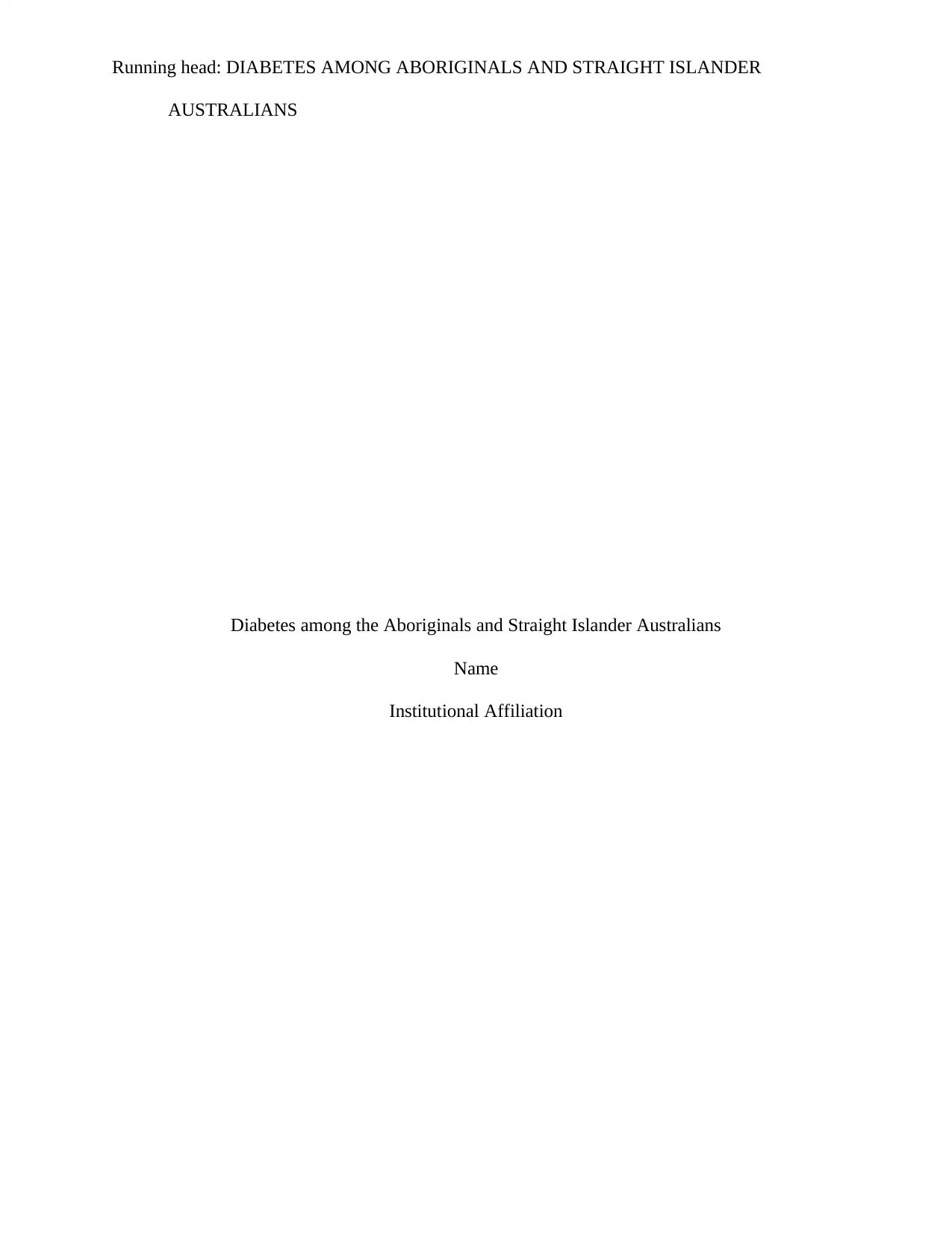
Running head: DIABETES AMONG ABORIGINALS AND STRAIGHT ISLANDER
AUSTRALIANS
Diabetes among the Aboriginals and Straight Islander Australians
Name
Institutional Affiliation
AUSTRALIANS
Diabetes among the Aboriginals and Straight Islander Australians
Name
Institutional Affiliation
Paraphrase This Document
Need a fresh take? Get an instant paraphrase of this document with our AI Paraphraser
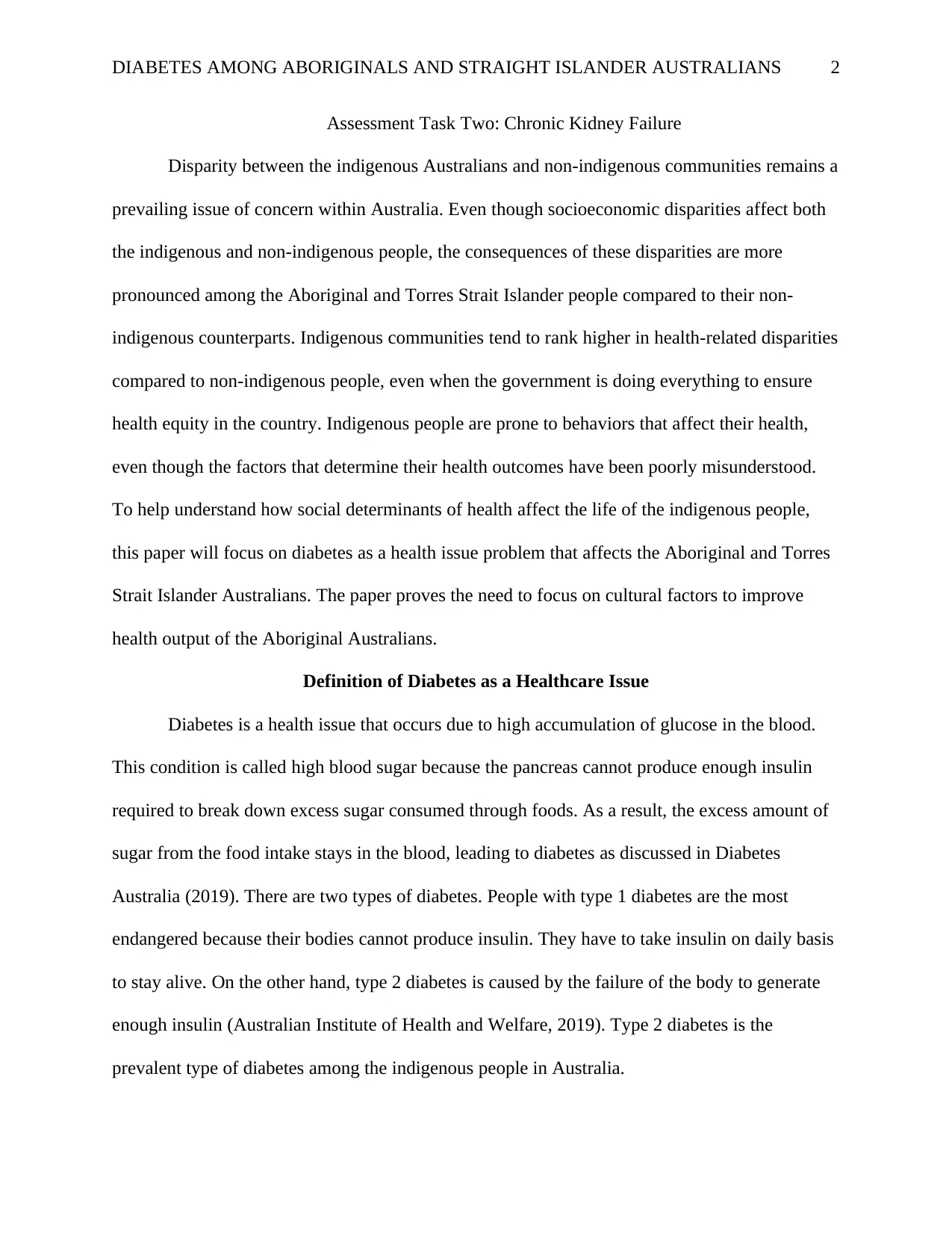
DIABETES AMONG ABORIGINALS AND STRAIGHT ISLANDER AUSTRALIANS 2
Assessment Task Two: Chronic Kidney Failure
Disparity between the indigenous Australians and non-indigenous communities remains a
prevailing issue of concern within Australia. Even though socioeconomic disparities affect both
the indigenous and non-indigenous people, the consequences of these disparities are more
pronounced among the Aboriginal and Torres Strait Islander people compared to their non-
indigenous counterparts. Indigenous communities tend to rank higher in health-related disparities
compared to non-indigenous people, even when the government is doing everything to ensure
health equity in the country. Indigenous people are prone to behaviors that affect their health,
even though the factors that determine their health outcomes have been poorly misunderstood.
To help understand how social determinants of health affect the life of the indigenous people,
this paper will focus on diabetes as a health issue problem that affects the Aboriginal and Torres
Strait Islander Australians. The paper proves the need to focus on cultural factors to improve
health output of the Aboriginal Australians.
Definition of Diabetes as a Healthcare Issue
Diabetes is a health issue that occurs due to high accumulation of glucose in the blood.
This condition is called high blood sugar because the pancreas cannot produce enough insulin
required to break down excess sugar consumed through foods. As a result, the excess amount of
sugar from the food intake stays in the blood, leading to diabetes as discussed in Diabetes
Australia (2019). There are two types of diabetes. People with type 1 diabetes are the most
endangered because their bodies cannot produce insulin. They have to take insulin on daily basis
to stay alive. On the other hand, type 2 diabetes is caused by the failure of the body to generate
enough insulin (Australian Institute of Health and Welfare, 2019). Type 2 diabetes is the
prevalent type of diabetes among the indigenous people in Australia.
Assessment Task Two: Chronic Kidney Failure
Disparity between the indigenous Australians and non-indigenous communities remains a
prevailing issue of concern within Australia. Even though socioeconomic disparities affect both
the indigenous and non-indigenous people, the consequences of these disparities are more
pronounced among the Aboriginal and Torres Strait Islander people compared to their non-
indigenous counterparts. Indigenous communities tend to rank higher in health-related disparities
compared to non-indigenous people, even when the government is doing everything to ensure
health equity in the country. Indigenous people are prone to behaviors that affect their health,
even though the factors that determine their health outcomes have been poorly misunderstood.
To help understand how social determinants of health affect the life of the indigenous people,
this paper will focus on diabetes as a health issue problem that affects the Aboriginal and Torres
Strait Islander Australians. The paper proves the need to focus on cultural factors to improve
health output of the Aboriginal Australians.
Definition of Diabetes as a Healthcare Issue
Diabetes is a health issue that occurs due to high accumulation of glucose in the blood.
This condition is called high blood sugar because the pancreas cannot produce enough insulin
required to break down excess sugar consumed through foods. As a result, the excess amount of
sugar from the food intake stays in the blood, leading to diabetes as discussed in Diabetes
Australia (2019). There are two types of diabetes. People with type 1 diabetes are the most
endangered because their bodies cannot produce insulin. They have to take insulin on daily basis
to stay alive. On the other hand, type 2 diabetes is caused by the failure of the body to generate
enough insulin (Australian Institute of Health and Welfare, 2019). Type 2 diabetes is the
prevalent type of diabetes among the indigenous people in Australia.
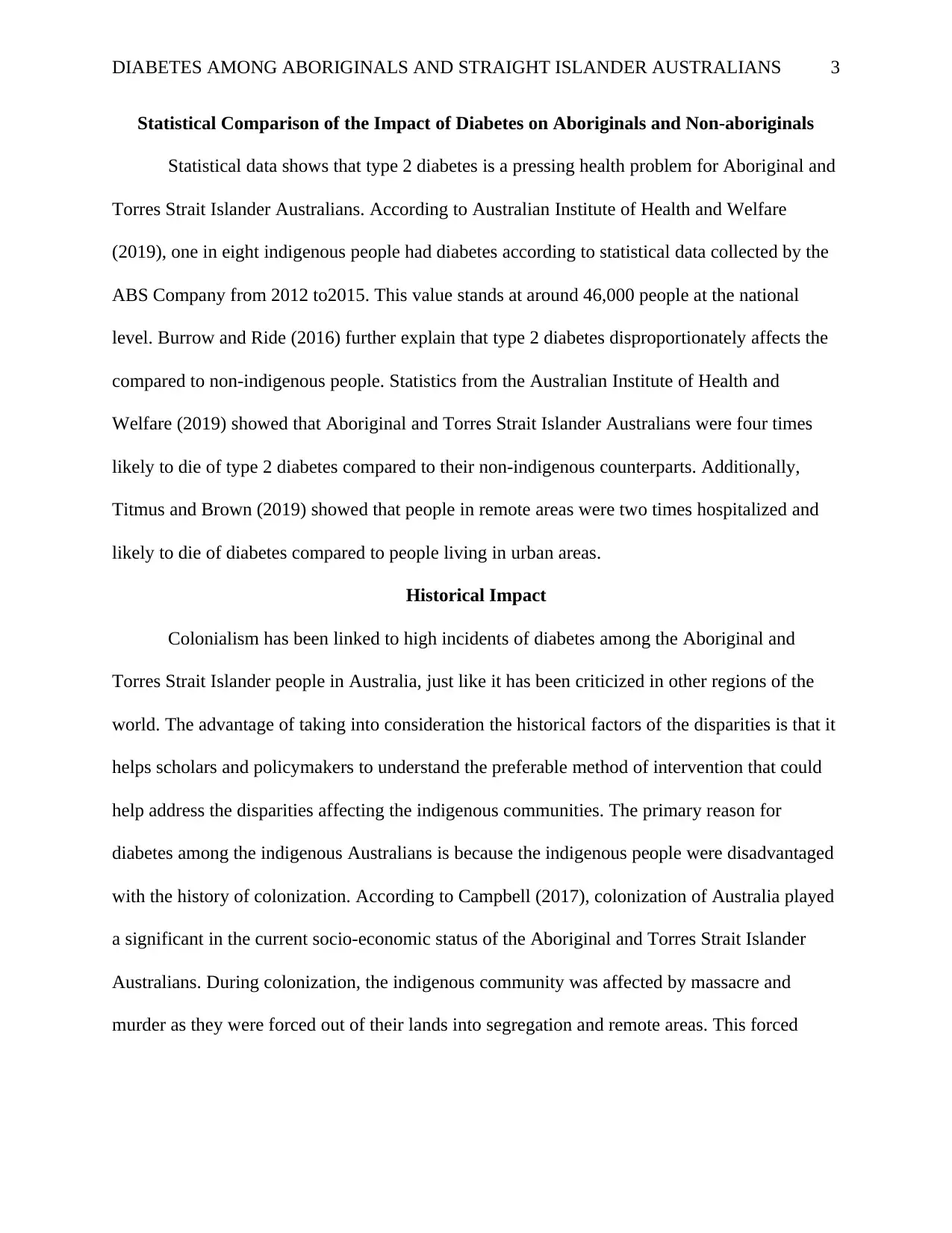
DIABETES AMONG ABORIGINALS AND STRAIGHT ISLANDER AUSTRALIANS 3
Statistical Comparison of the Impact of Diabetes on Aboriginals and Non-aboriginals
Statistical data shows that type 2 diabetes is a pressing health problem for Aboriginal and
Torres Strait Islander Australians. According to Australian Institute of Health and Welfare
(2019), one in eight indigenous people had diabetes according to statistical data collected by the
ABS Company from 2012 to2015. This value stands at around 46,000 people at the national
level. Burrow and Ride (2016) further explain that type 2 diabetes disproportionately affects the
compared to non-indigenous people. Statistics from the Australian Institute of Health and
Welfare (2019) showed that Aboriginal and Torres Strait Islander Australians were four times
likely to die of type 2 diabetes compared to their non-indigenous counterparts. Additionally,
Titmus and Brown (2019) showed that people in remote areas were two times hospitalized and
likely to die of diabetes compared to people living in urban areas.
Historical Impact
Colonialism has been linked to high incidents of diabetes among the Aboriginal and
Torres Strait Islander people in Australia, just like it has been criticized in other regions of the
world. The advantage of taking into consideration the historical factors of the disparities is that it
helps scholars and policymakers to understand the preferable method of intervention that could
help address the disparities affecting the indigenous communities. The primary reason for
diabetes among the indigenous Australians is because the indigenous people were disadvantaged
with the history of colonization. According to Campbell (2017), colonization of Australia played
a significant in the current socio-economic status of the Aboriginal and Torres Strait Islander
Australians. During colonization, the indigenous community was affected by massacre and
murder as they were forced out of their lands into segregation and remote areas. This forced
Statistical Comparison of the Impact of Diabetes on Aboriginals and Non-aboriginals
Statistical data shows that type 2 diabetes is a pressing health problem for Aboriginal and
Torres Strait Islander Australians. According to Australian Institute of Health and Welfare
(2019), one in eight indigenous people had diabetes according to statistical data collected by the
ABS Company from 2012 to2015. This value stands at around 46,000 people at the national
level. Burrow and Ride (2016) further explain that type 2 diabetes disproportionately affects the
compared to non-indigenous people. Statistics from the Australian Institute of Health and
Welfare (2019) showed that Aboriginal and Torres Strait Islander Australians were four times
likely to die of type 2 diabetes compared to their non-indigenous counterparts. Additionally,
Titmus and Brown (2019) showed that people in remote areas were two times hospitalized and
likely to die of diabetes compared to people living in urban areas.
Historical Impact
Colonialism has been linked to high incidents of diabetes among the Aboriginal and
Torres Strait Islander people in Australia, just like it has been criticized in other regions of the
world. The advantage of taking into consideration the historical factors of the disparities is that it
helps scholars and policymakers to understand the preferable method of intervention that could
help address the disparities affecting the indigenous communities. The primary reason for
diabetes among the indigenous Australians is because the indigenous people were disadvantaged
with the history of colonization. According to Campbell (2017), colonization of Australia played
a significant in the current socio-economic status of the Aboriginal and Torres Strait Islander
Australians. During colonization, the indigenous community was affected by massacre and
murder as they were forced out of their lands into segregation and remote areas. This forced
⊘ This is a preview!⊘
Do you want full access?
Subscribe today to unlock all pages.

Trusted by 1+ million students worldwide
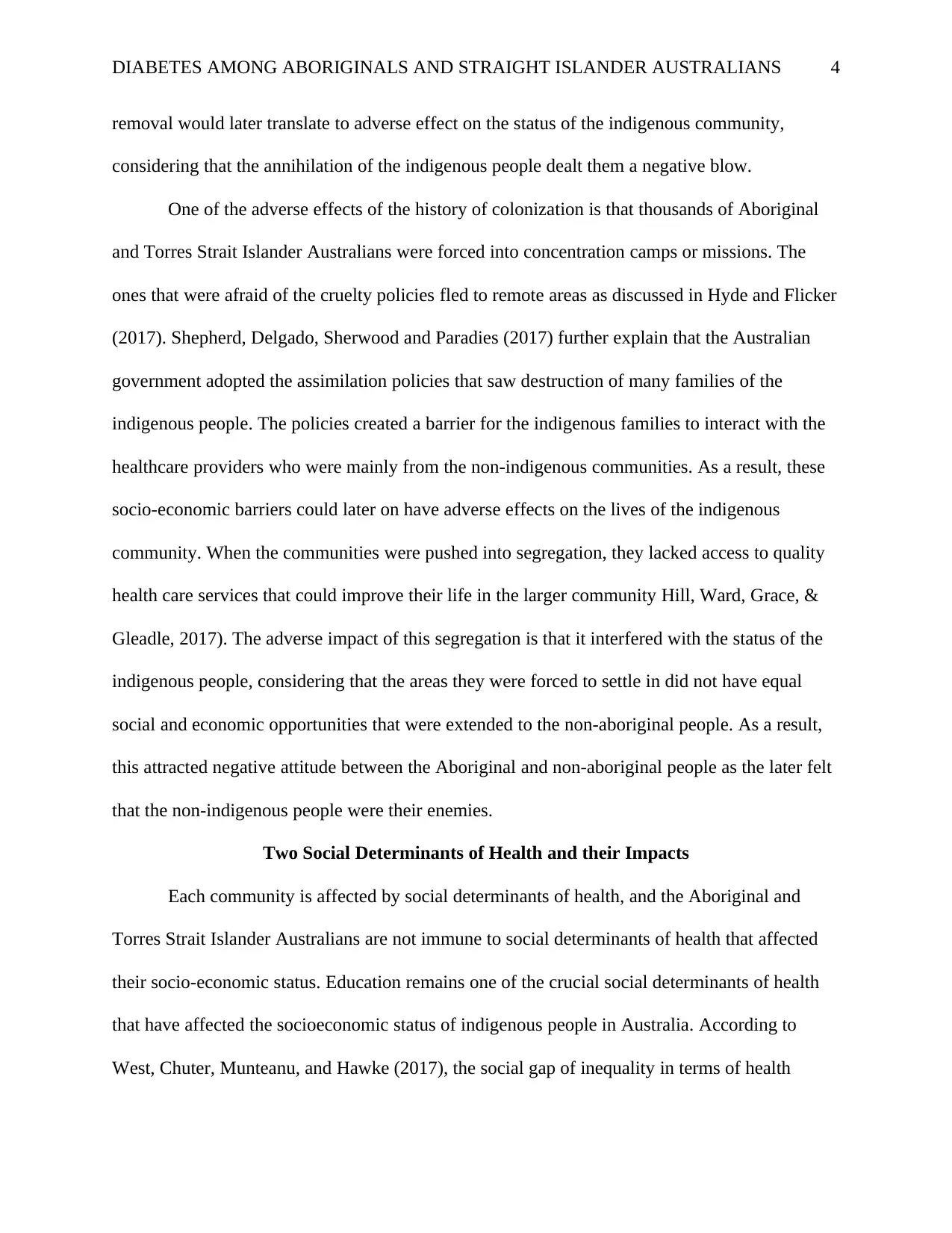
DIABETES AMONG ABORIGINALS AND STRAIGHT ISLANDER AUSTRALIANS 4
removal would later translate to adverse effect on the status of the indigenous community,
considering that the annihilation of the indigenous people dealt them a negative blow.
One of the adverse effects of the history of colonization is that thousands of Aboriginal
and Torres Strait Islander Australians were forced into concentration camps or missions. The
ones that were afraid of the cruelty policies fled to remote areas as discussed in Hyde and Flicker
(2017). Shepherd, Delgado, Sherwood and Paradies (2017) further explain that the Australian
government adopted the assimilation policies that saw destruction of many families of the
indigenous people. The policies created a barrier for the indigenous families to interact with the
healthcare providers who were mainly from the non-indigenous communities. As a result, these
socio-economic barriers could later on have adverse effects on the lives of the indigenous
community. When the communities were pushed into segregation, they lacked access to quality
health care services that could improve their life in the larger community Hill, Ward, Grace, &
Gleadle, 2017). The adverse impact of this segregation is that it interfered with the status of the
indigenous people, considering that the areas they were forced to settle in did not have equal
social and economic opportunities that were extended to the non-aboriginal people. As a result,
this attracted negative attitude between the Aboriginal and non-aboriginal people as the later felt
that the non-indigenous people were their enemies.
Two Social Determinants of Health and their Impacts
Each community is affected by social determinants of health, and the Aboriginal and
Torres Strait Islander Australians are not immune to social determinants of health that affected
their socio-economic status. Education remains one of the crucial social determinants of health
that have affected the socioeconomic status of indigenous people in Australia. According to
West, Chuter, Munteanu, and Hawke (2017), the social gap of inequality in terms of health
removal would later translate to adverse effect on the status of the indigenous community,
considering that the annihilation of the indigenous people dealt them a negative blow.
One of the adverse effects of the history of colonization is that thousands of Aboriginal
and Torres Strait Islander Australians were forced into concentration camps or missions. The
ones that were afraid of the cruelty policies fled to remote areas as discussed in Hyde and Flicker
(2017). Shepherd, Delgado, Sherwood and Paradies (2017) further explain that the Australian
government adopted the assimilation policies that saw destruction of many families of the
indigenous people. The policies created a barrier for the indigenous families to interact with the
healthcare providers who were mainly from the non-indigenous communities. As a result, these
socio-economic barriers could later on have adverse effects on the lives of the indigenous
community. When the communities were pushed into segregation, they lacked access to quality
health care services that could improve their life in the larger community Hill, Ward, Grace, &
Gleadle, 2017). The adverse impact of this segregation is that it interfered with the status of the
indigenous people, considering that the areas they were forced to settle in did not have equal
social and economic opportunities that were extended to the non-aboriginal people. As a result,
this attracted negative attitude between the Aboriginal and non-aboriginal people as the later felt
that the non-indigenous people were their enemies.
Two Social Determinants of Health and their Impacts
Each community is affected by social determinants of health, and the Aboriginal and
Torres Strait Islander Australians are not immune to social determinants of health that affected
their socio-economic status. Education remains one of the crucial social determinants of health
that have affected the socioeconomic status of indigenous people in Australia. According to
West, Chuter, Munteanu, and Hawke (2017), the social gap of inequality in terms of health
Paraphrase This Document
Need a fresh take? Get an instant paraphrase of this document with our AI Paraphraser
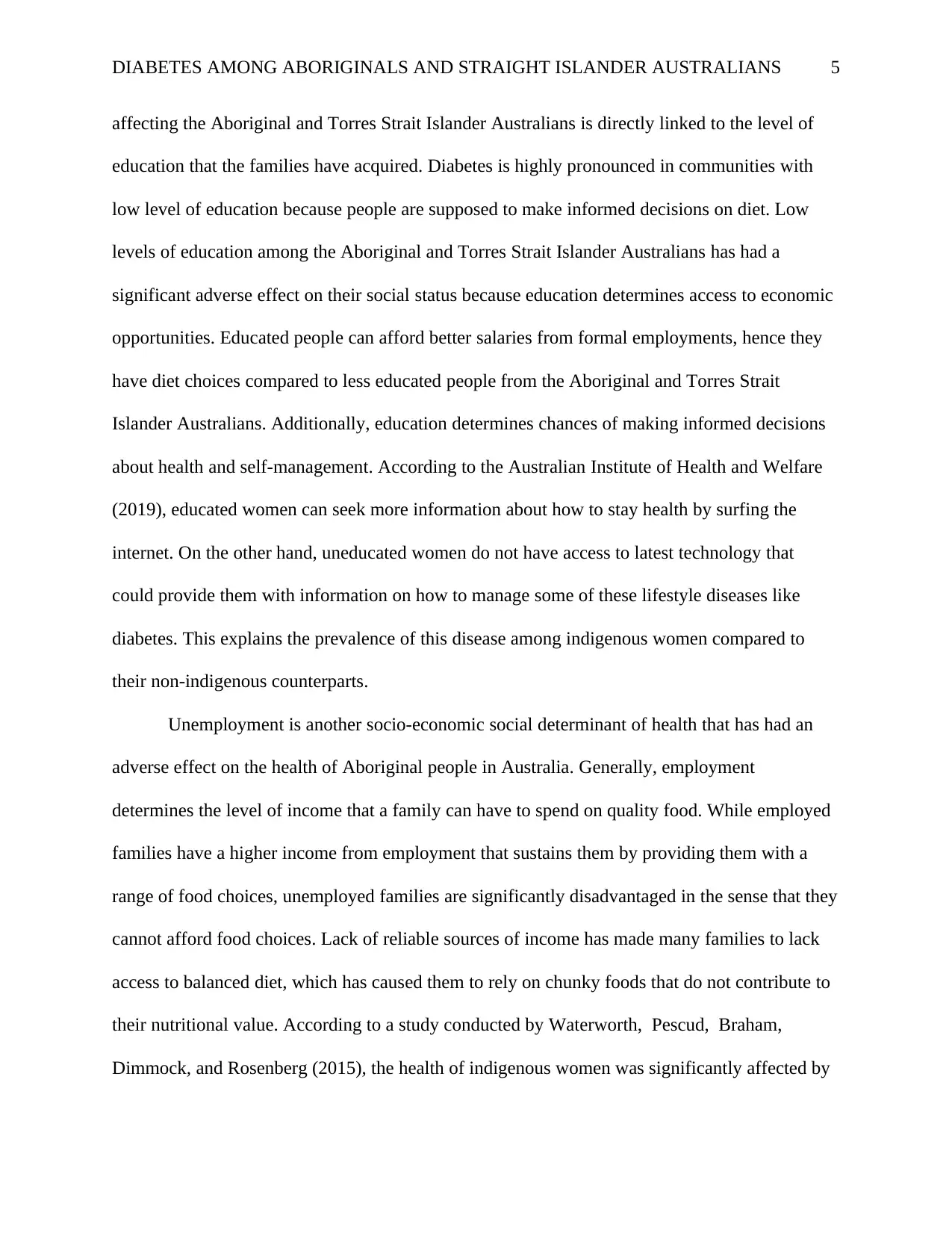
DIABETES AMONG ABORIGINALS AND STRAIGHT ISLANDER AUSTRALIANS 5
affecting the Aboriginal and Torres Strait Islander Australians is directly linked to the level of
education that the families have acquired. Diabetes is highly pronounced in communities with
low level of education because people are supposed to make informed decisions on diet. Low
levels of education among the Aboriginal and Torres Strait Islander Australians has had a
significant adverse effect on their social status because education determines access to economic
opportunities. Educated people can afford better salaries from formal employments, hence they
have diet choices compared to less educated people from the Aboriginal and Torres Strait
Islander Australians. Additionally, education determines chances of making informed decisions
about health and self-management. According to the Australian Institute of Health and Welfare
(2019), educated women can seek more information about how to stay health by surfing the
internet. On the other hand, uneducated women do not have access to latest technology that
could provide them with information on how to manage some of these lifestyle diseases like
diabetes. This explains the prevalence of this disease among indigenous women compared to
their non-indigenous counterparts.
Unemployment is another socio-economic social determinant of health that has had an
adverse effect on the health of Aboriginal people in Australia. Generally, employment
determines the level of income that a family can have to spend on quality food. While employed
families have a higher income from employment that sustains them by providing them with a
range of food choices, unemployed families are significantly disadvantaged in the sense that they
cannot afford food choices. Lack of reliable sources of income has made many families to lack
access to balanced diet, which has caused them to rely on chunky foods that do not contribute to
their nutritional value. According to a study conducted by Waterworth, Pescud, Braham,
Dimmock, and Rosenberg (2015), the health of indigenous women was significantly affected by
affecting the Aboriginal and Torres Strait Islander Australians is directly linked to the level of
education that the families have acquired. Diabetes is highly pronounced in communities with
low level of education because people are supposed to make informed decisions on diet. Low
levels of education among the Aboriginal and Torres Strait Islander Australians has had a
significant adverse effect on their social status because education determines access to economic
opportunities. Educated people can afford better salaries from formal employments, hence they
have diet choices compared to less educated people from the Aboriginal and Torres Strait
Islander Australians. Additionally, education determines chances of making informed decisions
about health and self-management. According to the Australian Institute of Health and Welfare
(2019), educated women can seek more information about how to stay health by surfing the
internet. On the other hand, uneducated women do not have access to latest technology that
could provide them with information on how to manage some of these lifestyle diseases like
diabetes. This explains the prevalence of this disease among indigenous women compared to
their non-indigenous counterparts.
Unemployment is another socio-economic social determinant of health that has had an
adverse effect on the health of Aboriginal people in Australia. Generally, employment
determines the level of income that a family can have to spend on quality food. While employed
families have a higher income from employment that sustains them by providing them with a
range of food choices, unemployed families are significantly disadvantaged in the sense that they
cannot afford food choices. Lack of reliable sources of income has made many families to lack
access to balanced diet, which has caused them to rely on chunky foods that do not contribute to
their nutritional value. According to a study conducted by Waterworth, Pescud, Braham,
Dimmock, and Rosenberg (2015), the health of indigenous women was significantly affected by
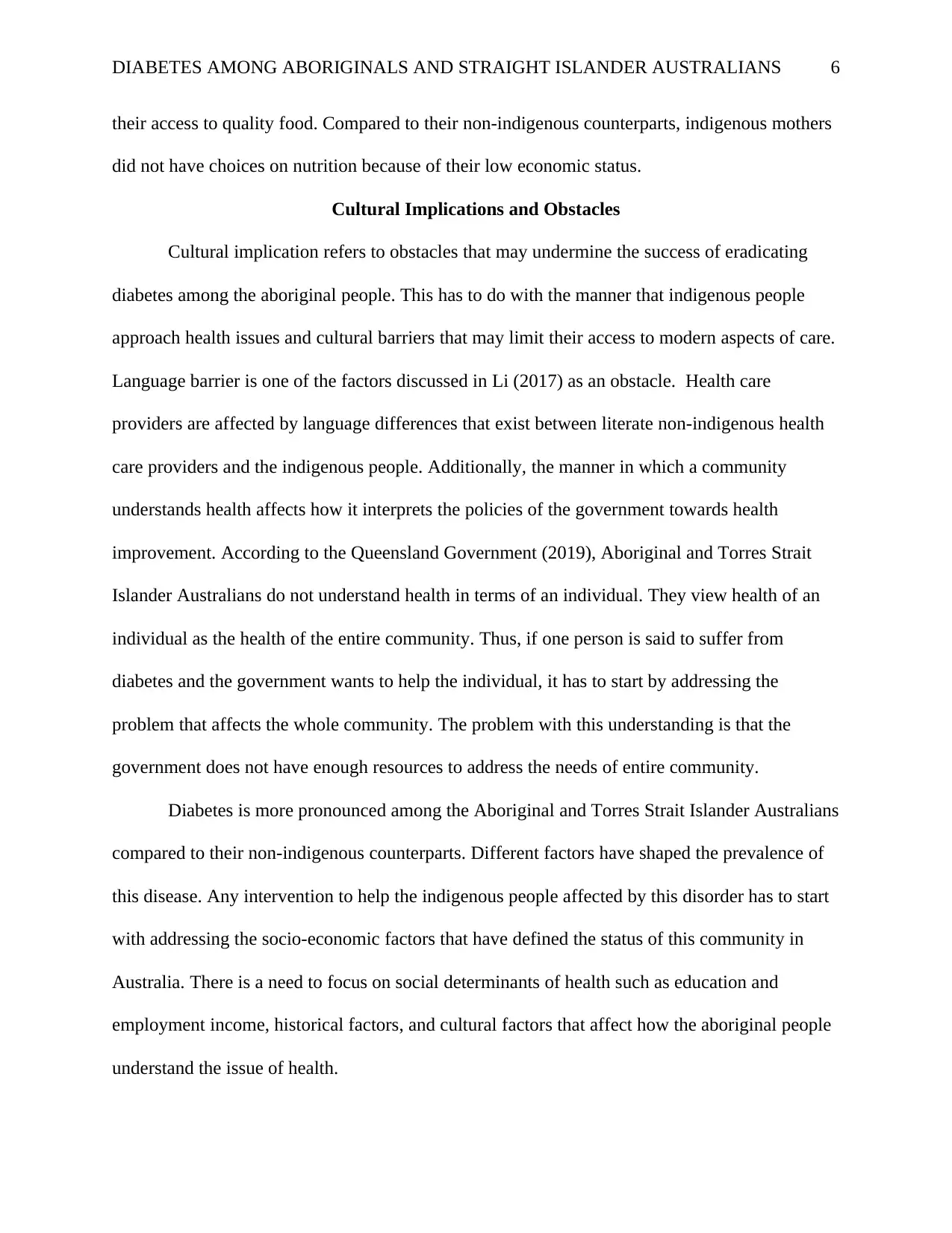
DIABETES AMONG ABORIGINALS AND STRAIGHT ISLANDER AUSTRALIANS 6
their access to quality food. Compared to their non-indigenous counterparts, indigenous mothers
did not have choices on nutrition because of their low economic status.
Cultural Implications and Obstacles
Cultural implication refers to obstacles that may undermine the success of eradicating
diabetes among the aboriginal people. This has to do with the manner that indigenous people
approach health issues and cultural barriers that may limit their access to modern aspects of care.
Language barrier is one of the factors discussed in Li (2017) as an obstacle. Health care
providers are affected by language differences that exist between literate non-indigenous health
care providers and the indigenous people. Additionally, the manner in which a community
understands health affects how it interprets the policies of the government towards health
improvement. According to the Queensland Government (2019), Aboriginal and Torres Strait
Islander Australians do not understand health in terms of an individual. They view health of an
individual as the health of the entire community. Thus, if one person is said to suffer from
diabetes and the government wants to help the individual, it has to start by addressing the
problem that affects the whole community. The problem with this understanding is that the
government does not have enough resources to address the needs of entire community.
Diabetes is more pronounced among the Aboriginal and Torres Strait Islander Australians
compared to their non-indigenous counterparts. Different factors have shaped the prevalence of
this disease. Any intervention to help the indigenous people affected by this disorder has to start
with addressing the socio-economic factors that have defined the status of this community in
Australia. There is a need to focus on social determinants of health such as education and
employment income, historical factors, and cultural factors that affect how the aboriginal people
understand the issue of health.
their access to quality food. Compared to their non-indigenous counterparts, indigenous mothers
did not have choices on nutrition because of their low economic status.
Cultural Implications and Obstacles
Cultural implication refers to obstacles that may undermine the success of eradicating
diabetes among the aboriginal people. This has to do with the manner that indigenous people
approach health issues and cultural barriers that may limit their access to modern aspects of care.
Language barrier is one of the factors discussed in Li (2017) as an obstacle. Health care
providers are affected by language differences that exist between literate non-indigenous health
care providers and the indigenous people. Additionally, the manner in which a community
understands health affects how it interprets the policies of the government towards health
improvement. According to the Queensland Government (2019), Aboriginal and Torres Strait
Islander Australians do not understand health in terms of an individual. They view health of an
individual as the health of the entire community. Thus, if one person is said to suffer from
diabetes and the government wants to help the individual, it has to start by addressing the
problem that affects the whole community. The problem with this understanding is that the
government does not have enough resources to address the needs of entire community.
Diabetes is more pronounced among the Aboriginal and Torres Strait Islander Australians
compared to their non-indigenous counterparts. Different factors have shaped the prevalence of
this disease. Any intervention to help the indigenous people affected by this disorder has to start
with addressing the socio-economic factors that have defined the status of this community in
Australia. There is a need to focus on social determinants of health such as education and
employment income, historical factors, and cultural factors that affect how the aboriginal people
understand the issue of health.
⊘ This is a preview!⊘
Do you want full access?
Subscribe today to unlock all pages.

Trusted by 1+ million students worldwide
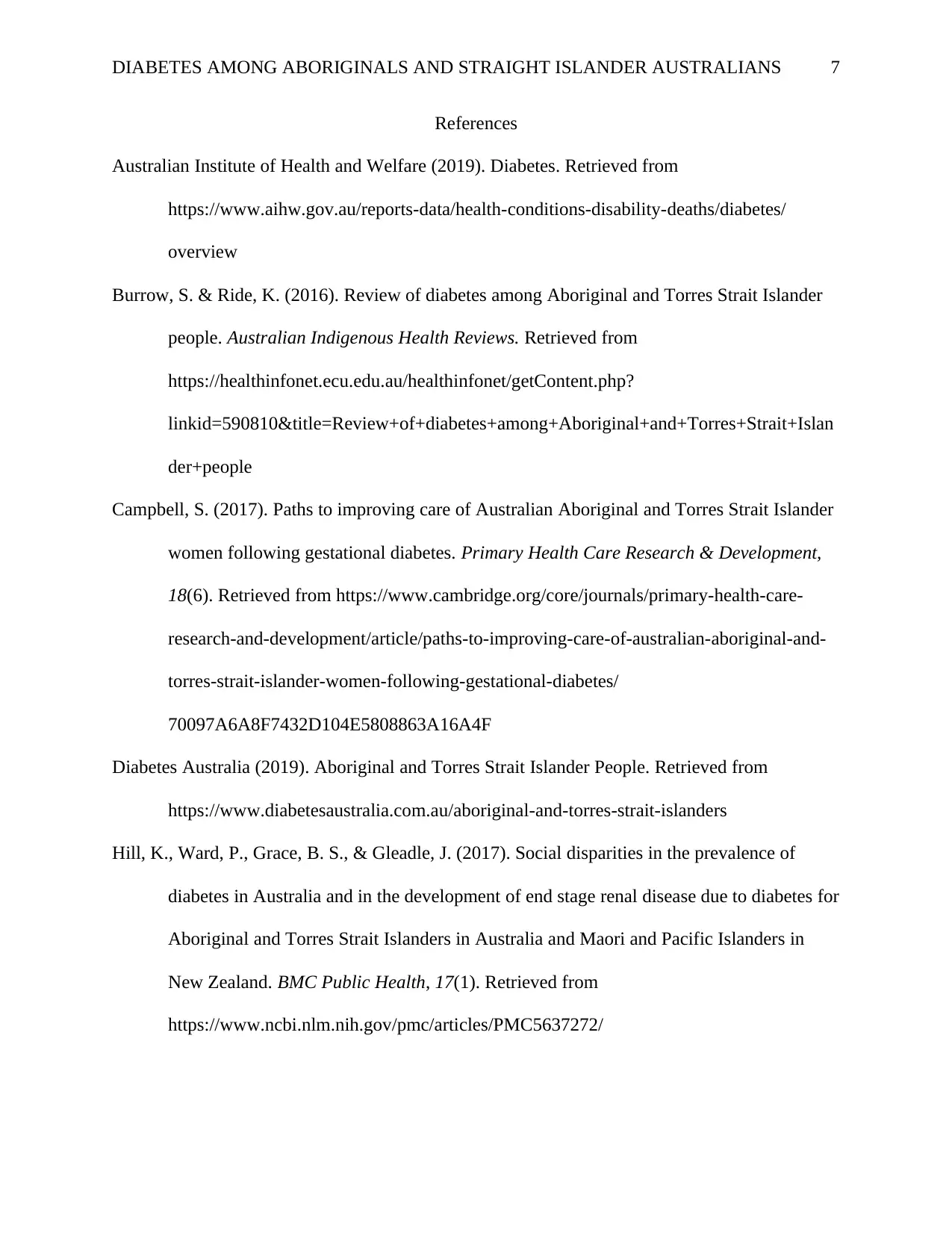
DIABETES AMONG ABORIGINALS AND STRAIGHT ISLANDER AUSTRALIANS 7
References
Australian Institute of Health and Welfare (2019). Diabetes. Retrieved from
https://www.aihw.gov.au/reports-data/health-conditions-disability-deaths/diabetes/
overview
Burrow, S. & Ride, K. (2016). Review of diabetes among Aboriginal and Torres Strait Islander
people. Australian Indigenous Health Reviews. Retrieved from
https://healthinfonet.ecu.edu.au/healthinfonet/getContent.php?
linkid=590810&title=Review+of+diabetes+among+Aboriginal+and+Torres+Strait+Islan
der+people
Campbell, S. (2017). Paths to improving care of Australian Aboriginal and Torres Strait Islander
women following gestational diabetes. Primary Health Care Research & Development,
18(6). Retrieved from https://www.cambridge.org/core/journals/primary-health-care-
research-and-development/article/paths-to-improving-care-of-australian-aboriginal-and-
torres-strait-islander-women-following-gestational-diabetes/
70097A6A8F7432D104E5808863A16A4F
Diabetes Australia (2019). Aboriginal and Torres Strait Islander People. Retrieved from
https://www.diabetesaustralia.com.au/aboriginal-and-torres-strait-islanders
Hill, K., Ward, P., Grace, B. S., & Gleadle, J. (2017). Social disparities in the prevalence of
diabetes in Australia and in the development of end stage renal disease due to diabetes for
Aboriginal and Torres Strait Islanders in Australia and Maori and Pacific Islanders in
New Zealand. BMC Public Health, 17(1). Retrieved from
https://www.ncbi.nlm.nih.gov/pmc/articles/PMC5637272/
References
Australian Institute of Health and Welfare (2019). Diabetes. Retrieved from
https://www.aihw.gov.au/reports-data/health-conditions-disability-deaths/diabetes/
overview
Burrow, S. & Ride, K. (2016). Review of diabetes among Aboriginal and Torres Strait Islander
people. Australian Indigenous Health Reviews. Retrieved from
https://healthinfonet.ecu.edu.au/healthinfonet/getContent.php?
linkid=590810&title=Review+of+diabetes+among+Aboriginal+and+Torres+Strait+Islan
der+people
Campbell, S. (2017). Paths to improving care of Australian Aboriginal and Torres Strait Islander
women following gestational diabetes. Primary Health Care Research & Development,
18(6). Retrieved from https://www.cambridge.org/core/journals/primary-health-care-
research-and-development/article/paths-to-improving-care-of-australian-aboriginal-and-
torres-strait-islander-women-following-gestational-diabetes/
70097A6A8F7432D104E5808863A16A4F
Diabetes Australia (2019). Aboriginal and Torres Strait Islander People. Retrieved from
https://www.diabetesaustralia.com.au/aboriginal-and-torres-strait-islanders
Hill, K., Ward, P., Grace, B. S., & Gleadle, J. (2017). Social disparities in the prevalence of
diabetes in Australia and in the development of end stage renal disease due to diabetes for
Aboriginal and Torres Strait Islanders in Australia and Maori and Pacific Islanders in
New Zealand. BMC Public Health, 17(1). Retrieved from
https://www.ncbi.nlm.nih.gov/pmc/articles/PMC5637272/
Paraphrase This Document
Need a fresh take? Get an instant paraphrase of this document with our AI Paraphraser
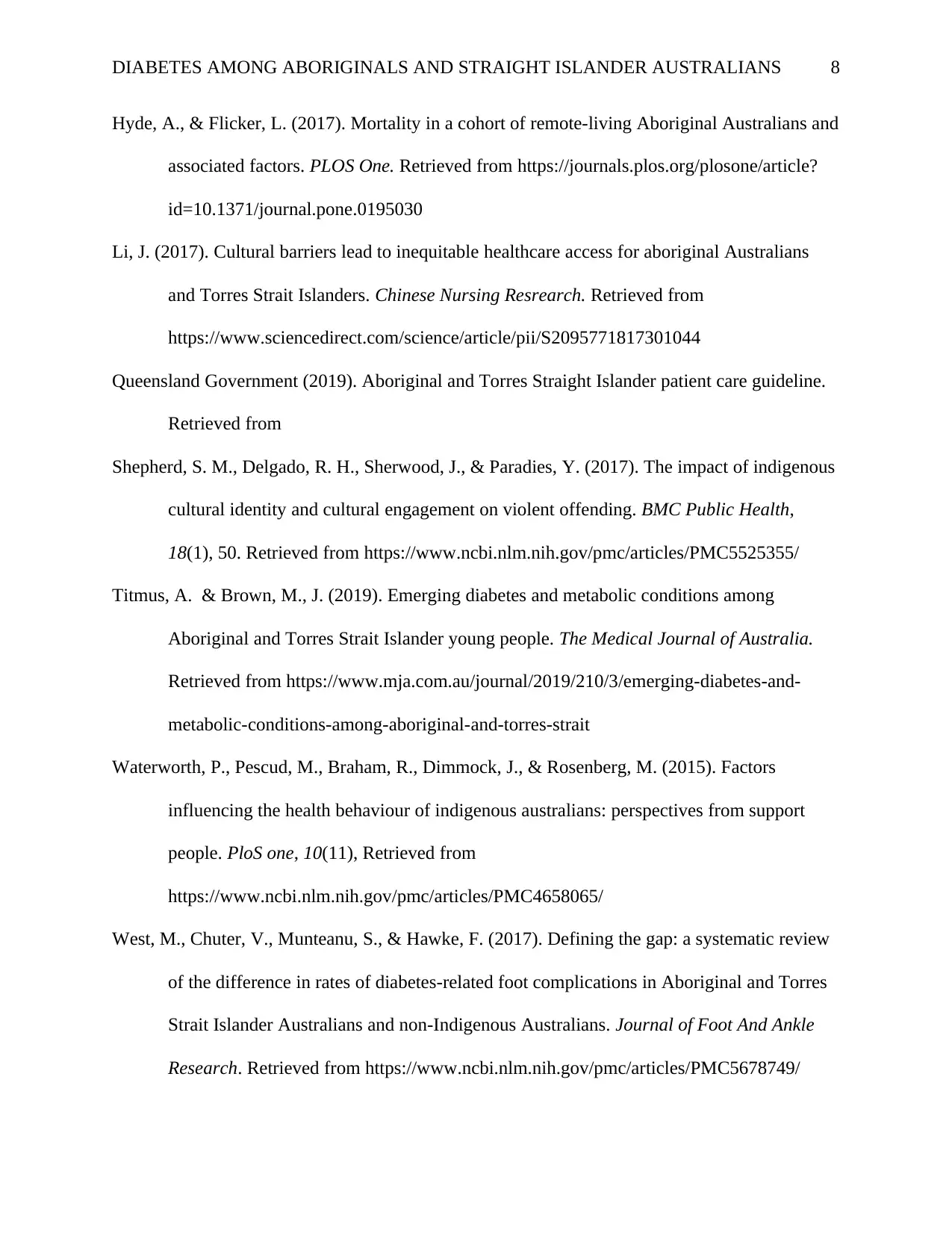
DIABETES AMONG ABORIGINALS AND STRAIGHT ISLANDER AUSTRALIANS 8
Hyde, A., & Flicker, L. (2017). Mortality in a cohort of remote-living Aboriginal Australians and
associated factors. PLOS One. Retrieved from https://journals.plos.org/plosone/article?
id=10.1371/journal.pone.0195030
Li, J. (2017). Cultural barriers lead to inequitable healthcare access for aboriginal Australians
and Torres Strait Islanders. Chinese Nursing Resrearch. Retrieved from
https://www.sciencedirect.com/science/article/pii/S2095771817301044
Queensland Government (2019). Aboriginal and Torres Straight Islander patient care guideline.
Retrieved from
Shepherd, S. M., Delgado, R. H., Sherwood, J., & Paradies, Y. (2017). The impact of indigenous
cultural identity and cultural engagement on violent offending. BMC Public Health,
18(1), 50. Retrieved from https://www.ncbi.nlm.nih.gov/pmc/articles/PMC5525355/
Titmus, A. & Brown, M., J. (2019). Emerging diabetes and metabolic conditions among
Aboriginal and Torres Strait Islander young people. The Medical Journal of Australia.
Retrieved from https://www.mja.com.au/journal/2019/210/3/emerging-diabetes-and-
metabolic-conditions-among-aboriginal-and-torres-strait
Waterworth, P., Pescud, M., Braham, R., Dimmock, J., & Rosenberg, M. (2015). Factors
influencing the health behaviour of indigenous australians: perspectives from support
people. PloS one, 10(11), Retrieved from
https://www.ncbi.nlm.nih.gov/pmc/articles/PMC4658065/
West, M., Chuter, V., Munteanu, S., & Hawke, F. (2017). Defining the gap: a systematic review
of the difference in rates of diabetes-related foot complications in Aboriginal and Torres
Strait Islander Australians and non-Indigenous Australians. Journal of Foot And Ankle
Research. Retrieved from https://www.ncbi.nlm.nih.gov/pmc/articles/PMC5678749/
Hyde, A., & Flicker, L. (2017). Mortality in a cohort of remote-living Aboriginal Australians and
associated factors. PLOS One. Retrieved from https://journals.plos.org/plosone/article?
id=10.1371/journal.pone.0195030
Li, J. (2017). Cultural barriers lead to inequitable healthcare access for aboriginal Australians
and Torres Strait Islanders. Chinese Nursing Resrearch. Retrieved from
https://www.sciencedirect.com/science/article/pii/S2095771817301044
Queensland Government (2019). Aboriginal and Torres Straight Islander patient care guideline.
Retrieved from
Shepherd, S. M., Delgado, R. H., Sherwood, J., & Paradies, Y. (2017). The impact of indigenous
cultural identity and cultural engagement on violent offending. BMC Public Health,
18(1), 50. Retrieved from https://www.ncbi.nlm.nih.gov/pmc/articles/PMC5525355/
Titmus, A. & Brown, M., J. (2019). Emerging diabetes and metabolic conditions among
Aboriginal and Torres Strait Islander young people. The Medical Journal of Australia.
Retrieved from https://www.mja.com.au/journal/2019/210/3/emerging-diabetes-and-
metabolic-conditions-among-aboriginal-and-torres-strait
Waterworth, P., Pescud, M., Braham, R., Dimmock, J., & Rosenberg, M. (2015). Factors
influencing the health behaviour of indigenous australians: perspectives from support
people. PloS one, 10(11), Retrieved from
https://www.ncbi.nlm.nih.gov/pmc/articles/PMC4658065/
West, M., Chuter, V., Munteanu, S., & Hawke, F. (2017). Defining the gap: a systematic review
of the difference in rates of diabetes-related foot complications in Aboriginal and Torres
Strait Islander Australians and non-Indigenous Australians. Journal of Foot And Ankle
Research. Retrieved from https://www.ncbi.nlm.nih.gov/pmc/articles/PMC5678749/
1 out of 8
Related Documents
Your All-in-One AI-Powered Toolkit for Academic Success.
+13062052269
info@desklib.com
Available 24*7 on WhatsApp / Email
![[object Object]](/_next/static/media/star-bottom.7253800d.svg)
Unlock your academic potential
Copyright © 2020–2025 A2Z Services. All Rights Reserved. Developed and managed by ZUCOL.





![Diabetes Mellitus and Health Promotion Campaign Report - [University]](/_next/image/?url=https%3A%2F%2Fdesklib.com%2Fmedia%2Fimages%2Fws%2F94896ae70d2542399b982aab97667cb3.jpg&w=256&q=75)